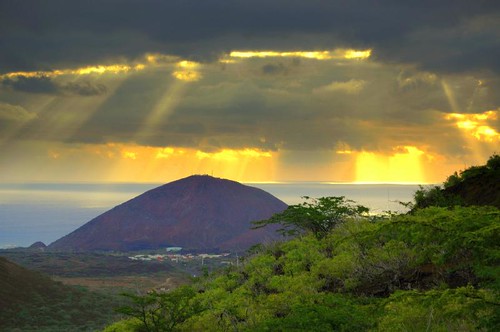Here's a fascinating article at the BBC about the "world's first experiment in terraforming."
Two hundred years ago, Ascension Island was a barren volcanic edifice.
Today, its peaks are covered by lush tropical "cloud forest".
What happened in the interim is the amazing story of how the architect of evolution, Kew Gardens and the Royal Navy conspired to build a fully functioning, but totally artificial ecosystem.
In 1836, Charles Darwin stopped at Ascension Island, a volcanic "cinder" of an island in the south Atlantic, completely devoid of trees. A few years later, his friend, the botanist Joseph Hooker, also visited the island.
Ascension was a strategic base for the Royal Navy. Originally set up to keep a watchful eye on the exiled emperor Napoleon on nearby St Helena, it was a thriving waystation at the time of Hooker's visit.
However, the big problem that impeded further expansion of this imperial outpost was the supply of fresh water.
Ascension was an arid island, buffeted by dry trade winds from southern Africa. Devoid of trees at the time of Darwin and Hooker's visits, the little rain that did fall quickly evaporated away.
Egged on by Darwin, in 1847 Hooker advised the Royal Navy to set in motion an elaborate plan. With the help of Kew Gardens - where Hooker's father was director - shipments of trees were to be sent to Ascension.
The idea was breathtakingly simple. Trees would capture more rain, reduce evaporation and create rich, loamy soils. The "cinder" would become a garden.
So, beginning in 1850 and continuing year after year, ships started to come. Each deposited a motley assortment of plants from botanical gardens in Europe, South Africa and Argentina.
These weren't invasive species, because there wasn't anything there to invade. But the cloud forest that exists there now is entirely artificial. According to the article, no one is studying it. If that's true, it's really a shame. How does the ecology function when everything has been brought to the island from elsewhere?
How about animal life? How about insects? Is the ecology stable, or still in flux. This seems remarkable to me. Surely, there's a lot we could learn from it. In fact, the article suggests that what we could learn there might be useful in terraforming Mars:
"What it tells us is that we can build a fully functioning ecosystem through a series of chance accidents or trial and error."
In effect, what Darwin, Hooker and the Royal Navy achieved was the world's first experiment in "terra-forming". They created a self-sustaining and self-reproducing ecosystem in order to make Ascension Island more habitable.
[Dr. Dave] Wilkinson thinks that the principles that emerge from that experiment could be used to transform future colonies on Mars. In other words, rather than trying to improve an environment by force, the best approach might be to work with life to help it "find its own way".
Naturally, terraforming Mars would be a lot bigger trick than this, but Ascension Island is worth studying, I'd think. Meanwhile, check out these pictures of Mars (I've copied one of them below). Neat as they are, just imagine them with green vegetation. That would be an enormous project, of course, but we'd have a whole world to gain.







1 comment:
That's really cool and you're right it should be treated as one of the most important experiments of the last 200 years, certainly not ignored.
Post a Comment